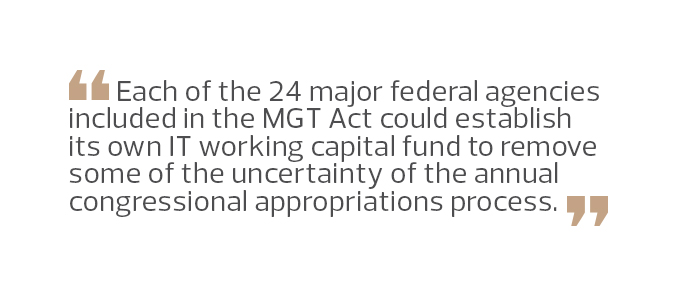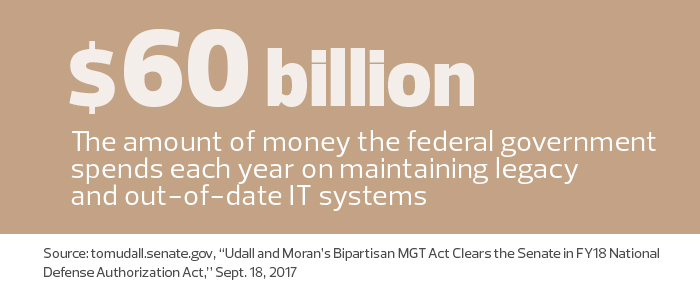sponsor content What's this?
How Agencies Can Use the MGT Act to Transform Their IT Architecture

Presented by
FedTech

Policymakers are increasingly interested in a technology fund as a way to pay for digital transformation efforts.
Agencies that hope to upgrade outdated and unsecured IT systems face an enduring challenge as both operating costs and cyberthreats continue to increase. Look no further than the recent WannaCry ransomware attack, which highlighted the risks of relying on older software such as Windows 95. While Microsoft has not supported that version of its operating system since 2001, some agencies still use it.
Help could be on the way.
A draft IT modernization report from the White House American Technology Council aims to reduce IT spending and improve services by changing how agencies access innovation and how they buy technology solutions. The report builds on public remarks from White House officials on the importance of IT reform and the need to bring a business sensibility to both government operations and services delivery.
Throughout Congress, bipartisan support for change exists, most notably through the Modernizing Government Technology Act. Agency leaders should prepare for this change and consider what it will mean for their organization’s future IT architecture. This could include streamlining IT systems, replacing legacy products and hardware, and shifting applications to the cloud.
Modernization Funds Gain Momentum
The MGT act, first introduced by Rep. Will Hurd, passed the House of Representatives unanimously earlier this year. The Senate approved similar language as an amendment to the 2018 National Defense Authorization Act in September. Broadly, this bill would establish a revolving, self-sustaining Technology Modernization Fund (TMF) to finance the modernization of legacy IT systems.
At the same time, the president’s budget request for fiscal year 2018 seeks $228 million in seed money for this fund. It also outlines how agencies could apply for funding and subsequently repay the fund through operating costs savings gained from projects such as cloud-based email adoption. White House leaders say the fund is designed to be competitive and provide incentives for agency leaders to modernize.
New Working Capital Funds May Spur Change
In addition to the new TMF, the MGT Act provides another, potentially more powerful tool to support IT modernization. Each of the 24 major federal agencies included in the MGT Act could establish its own IT working capital fund to remove some of the uncertainty of the annual congressional appropriations process.

This step would essentially allow an agency to begin investing in IT modernizations now, such as a move to the cloud or data center optimization, and draw from the working capital fund to pay for them over a three-year period. Previously, most agencies have not had such flexibility.
The development and operation of shared IT platforms could lead to more fee-for-service payments and, as a result, support the technology funds. This, in turn, could lead to additional modernization efforts. Investing in future savings could, over time, shift more of the government’s IT spending on legacy systems to new and more secure technology.
At some agencies, more than 90 percent of the IT budget is set aside for the operations and maintenance of legacy systems.
The MGT Act also includes congressional reporting and transparency requirements for oversight of such funds, a tool long used by lawmakers on other working capital funds.
What Can CIOs Expect if MGT Act Becomes Law?
Once this new funding mechanism becomes law, agencies should begin reprioritizing their modernization plans and develop the business case for their most pressing updates.
However, it will take time for the MGT Act to make an impact and revamp the modernization process. Here’s why:
First, Congress must appropriate funding to the modernization accounts.
Next, agencies would need to establish their working capital funds and provide seed money.

Third, the initial projects need to be selected with care, to demonstrate the value of this new approach and to verify the criteria and principles for prioritizing potential TMF investments. Agencies need to prove this approach will work.
In the meantime, IT leaders should not wait for the MGT Act before pushing forward with needed upgrades. Sometimes, partial and incremental modernization of vulnerable systems may make more sense, with later steps coming after the MGT Act is enacted and the TMF and other funds are established.
Choose IT Modernization Projects with Care
Initially, the best approach is for CIOs to start with the tried and true.
Patching security holes and buying new equipment are just the first steps toward achieving the IT modernization vision outlined in the American Technology Council report and by MGT Act supporters. The improved delivery of services, or process innovation, through technology upgrades can drive real value in meeting agencies’ missions. Contractors often offer government organizations excellent mechanisms for accessing innovation and identifying and implementing process improvements. The best results occur when agency leaders define outcomes and measure results based on a clear understanding of the full costs to achieving those outcomes.
In the end, improving how the government buys and manages IT is not really a technology issue; it is a way for government agencies to deliver better services and results at lower cost and better value to taxpayers.
This content is made possible by FedTech. The editorial staff of Nextgov was not involved in its preparation.


